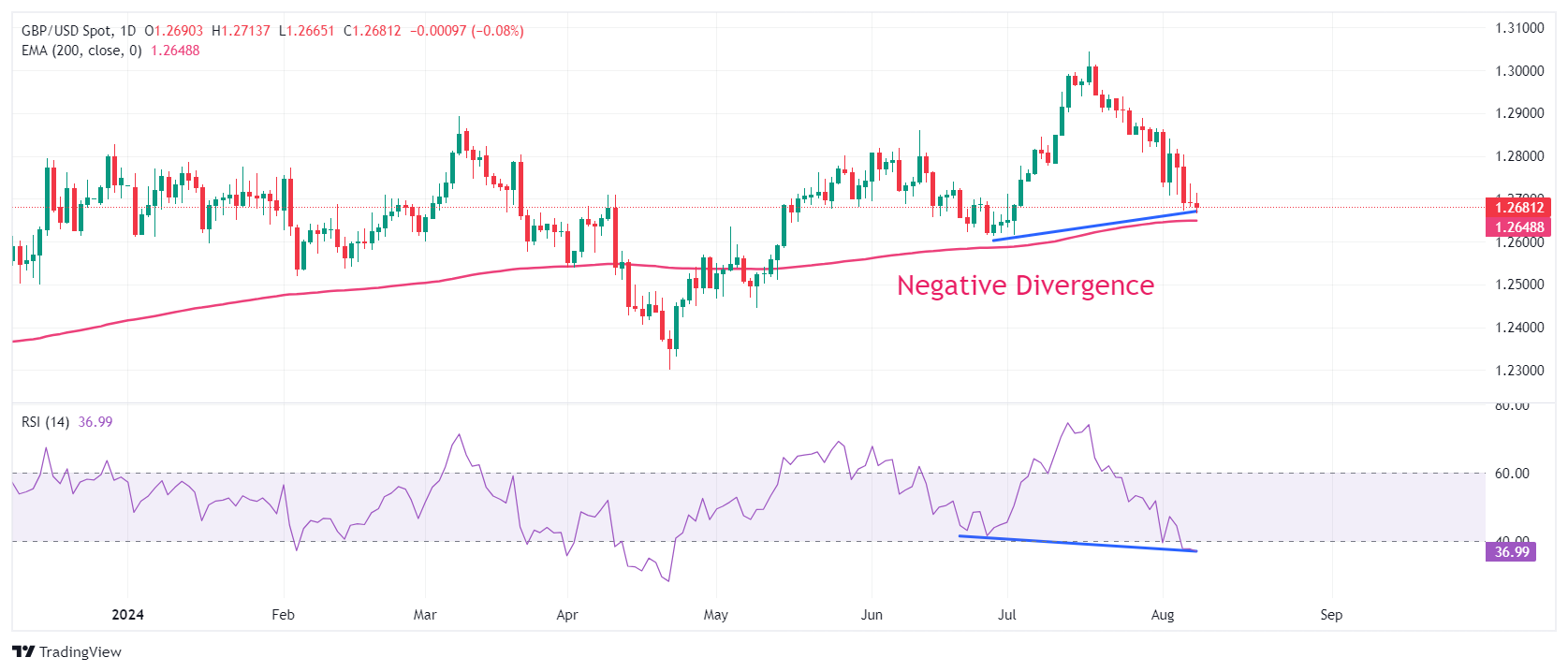- GBP/USD marks a fresh monthly low near 1.2665 as the US Dollar recovers.
- The US Dollar rebounds following lower US jobless claims for the week ending August 2.
- Cable extends its losing streak for a fourth trading day.
The GBP/USD pair is hovering at a fresh monthly low around 1.2665 in the American session on Thursday. The Cable is exhibiting a subdued performance as the US Dollar (USD) has recovered sharply following the release of the lower-than-expected initial jobless claims in the United States (US) for the week ending August 2.
The US Dollar Index (DXY), which tracks the greenback’s value against six major currencies, jumped near 103.40 after recovering intraday losses. The US Department of Labor showed that people filing for first-time unemployment benefits were lower at 233,000 versus estimates of 240,000 and the previous release of 249,000.
However, the near-term outlook for the US Dollar remains uncertain as low jobless claims would be insufficient to negatively impact market speculation that the Federal Reserve (Fed) will cut interest rates by more than 100 basis points (bps) this year.
Meanwhile, the British Pound (GBP) remains under pressure from global risk aversion. The British currency will be influenced by market expectations for rate cuts from the Bank of England (BoE) amid the absence of top-tier economic data from the United Kingdom (UK).
GBP/USD extends its losing streak for the fourth trading session on Thursday. Cable is at a decisive point below the crucial 1.2700 figure. The major exhibits a negative divergence formation on a daily time frame where the asset continues to build higher lows, while the momentum oscillator makes lower lows. This usually results in a bullish reversal, but needs to be confirmed by more indicators.
The 14-day RSI formed a fresh swing lower at 37.00, suggesting that the bearish momentum remains intact.
The asset is still holding the 200-day exponential moving average (EMA), which is trading around 1.2650.
Further downside could be on the cards if the asset breaks below the intraday low of 1.2665. This would expose the asset to the June 27 low at 1.2613, followed by the April 29 high at 1.2570.
On the other hand, a recovery move above the August 6 high at 1.2800 would propel the asset towards the August 2 high at 1.2840 and the round-level resistance of 1.2900.
GBP/USD daily chart
The British Pound FAQs
The Pound Sterling (GBP) is the oldest currency in the world (886 AD) and the official currency of the United Kingdom. It is the fourth most traded currency unit in the world, accounting for 12% of all transactions and an average of $630 billion a day, as of 2022.
Its key currency pairs are GBP/USD, also known as the “Cable,” which accounts for 11% of the forex market, GBP/JPY, or the “Dragon” as it is known to traders (3%), and EUR/GBP (2%). The British Pound is issued by the Bank of England (BoE).
The most important factor influencing the value of the British Pound is the monetary policy decided by the Bank of England. The Bank of England bases its decisions on achieving its main objective of “price stability”, i.e. a stable inflation rate of around 2%. Its main tool for achieving this is the adjustment of interest rates.
When inflation is too high, the Bank of England tries to contain it by raising interest rates, making credit more expensive for individuals and businesses. This is generally positive for the GBP, as higher interest rates make the UK a more attractive place for global investors to park their money.
When inflation is too low, it is a sign that economic growth is slowing. In this scenario, the BoE will consider lowering interest rates to make credit cheaper, so that companies borrow more to invest in growth-generating projects.
The data released gauges the health of the economy and can influence the value of the Pound. Indicators such as GDP, manufacturing and services PMIs, and employment can influence the direction of the Pound.
A strong economy is good for the British Pound. Not only does it attract more foreign investment, but it may encourage the Bank of England to raise interest rates, which will directly strengthen the British Pound. Conversely, if economic data is weak, the British Pound is likely to fall.
Another significant indicator for the pound is the trade balance. This indicator measures the difference between what a country earns from its exports and what it spends on imports during a given period.
If a country produces highly sought-after exports, its currency will benefit exclusively from the additional demand created by foreign buyers who wish to purchase these goods. Therefore, a positive net trade balance strengthens a currency and vice versa for a negative balance.
Source: Fx Street
I am Joshua Winder, a senior-level journalist and editor at World Stock Market. I specialize in covering news related to the stock market and economic trends. With more than 8 years of experience in this field, I have become an expert in financial reporting.








